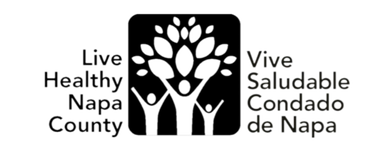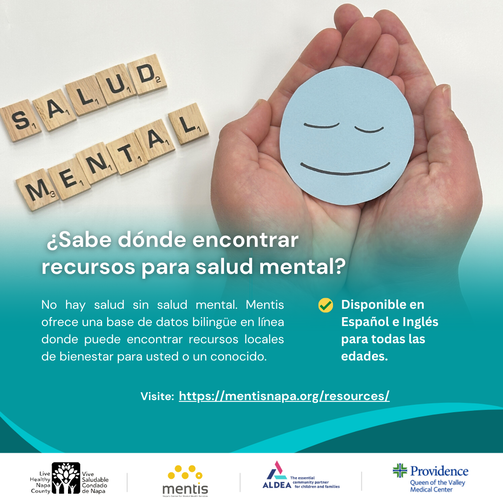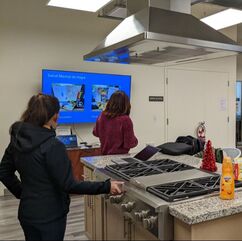COMMUNITY HEALTH ACTION PLAN (CHAP)
From 2019-2021, Live Healthy Napa County partners conducted ethnographic interviews, learning conversations, and focus groups to gain insight into Napa County community members’ sense of Respect and Social Inclusion (RSI). Respect and Social Inclusion is one of 8 domains that make up the Livable Communities framework.
In 2022, the data themes that emerged were used to collaboratively design and launch the community health projects described below. LHNC partners created 8 prospective projects and then voted to prioritize four of those ideas, focused on Youth, LGBTQ Safe Spaces, Language Inclusion, and Mental Wellness & Community Resiliency. These projects are based on iterative and consistent community engagement and are designed to be responsive to feedback cycles from the community. This page will be updated frequently to reflect project changes and progress.
Click here to view meeting notes, agendas and more from the CHAP teams.
In 2022, the data themes that emerged were used to collaboratively design and launch the community health projects described below. LHNC partners created 8 prospective projects and then voted to prioritize four of those ideas, focused on Youth, LGBTQ Safe Spaces, Language Inclusion, and Mental Wellness & Community Resiliency. These projects are based on iterative and consistent community engagement and are designed to be responsive to feedback cycles from the community. This page will be updated frequently to reflect project changes and progress.
Click here to view meeting notes, agendas and more from the CHAP teams.
Qualitative data themes
Community members felt that, while anxiety and depression were becoming more normalized, there is still a stigma around accessing mental wellness support for the entire spectrum of mental health needs. People felt that there were resources for acute mental health issues but perceived their own mental health needs as small or inconsequential in comparison to others. Mental Health professionals felt that great work is being done in Napa County, but the work is still happening in siloes with few opportunities for collaboration.
Project - Reduce barriers and stigma surrounding accessing mental wellness resources in Napa County.
Community members felt that, while anxiety and depression were becoming more normalized, there is still a stigma around accessing mental wellness support for the entire spectrum of mental health needs. People felt that there were resources for acute mental health issues but perceived their own mental health needs as small or inconsequential in comparison to others. Mental Health professionals felt that great work is being done in Napa County, but the work is still happening in siloes with few opportunities for collaboration.
Project - Reduce barriers and stigma surrounding accessing mental wellness resources in Napa County.
- The action planning group convened the Napa County mental wellness kit makers to collect kit data, leverage knowledge, resources, distribution expertise, and build capacity.
- The group provided information and feedback to Mentis’ existing resource list (https://mentisnapa.org/resources/). We are aiming for bilingual, culturally appropriate resources that address the full spectrum of mental wellness, and we will include information about kits available across the county.
- Current work is focused on amplifying the re-launch of Mentis’ bilingual resource database. The group is prototyping a bilingual flyer for distribution and will work to identify organizations/individuals to educate about the database (creating more opportunities for “warm handoffs”) and will use data from the Language inclusion group to refine the flyer distribution process.
Qualitative data themes
Spanish-speaking families reported concerns about not knowing where to go to receive information about emergencies and available community resources. They also expressed concern about receiving information that was late or inaccurate. Both English-speaking and Spanish-speaking residents in Napa County described a noticeable division between Latine and White communities in Napa County, naming language as a barrier to connection.
Project- Increase engagement with, and access for, Spanish-speaking community members
Spanish-speaking families reported concerns about not knowing where to go to receive information about emergencies and available community resources. They also expressed concern about receiving information that was late or inaccurate. Both English-speaking and Spanish-speaking residents in Napa County described a noticeable division between Latine and White communities in Napa County, naming language as a barrier to connection.
Project- Increase engagement with, and access for, Spanish-speaking community members
- Our Spanish-speaking community leaders feel the biggest issue facing their community is information access, so the first design sprint has focused on this topic.
- Community leaders and members of the Public Health Chronic Disease and Health Equity (CDHE) team have completed presentations in Spanish with Parent University, residents of Mayacamas Village and other multi-unit housing complexes across the county. At these presentations, they shared a county-wide Spanish language survey focused on access to services, information, and local government. To date, this team has engaged 61 Spanish Speaking community members through group interviews focused on information and resource access.
- A summary report has been created from group interviews and survey data summarizing key findings. The report can be found below.
- We are working on leveraging trusted messengers and information networks. A ‘Canvassing Locations’ document has been created to document information access points that Spanish speakers identified in the community.
Qualitative data themes
Teens reported feeling there is a lack of activities targeted towards their age group, and that it impacts their mental health. Teens reported boredom and stress as a cause of alcohol, tobacco, marijuana, and drug use and emphasized that there are few entertainment options for youth if you have limited finances.
Project- Youth Human Centered Design Sprint
Teens reported feeling there is a lack of activities targeted towards their age group, and that it impacts their mental health. Teens reported boredom and stress as a cause of alcohol, tobacco, marijuana, and drug use and emphasized that there are few entertainment options for youth if you have limited finances.
Project- Youth Human Centered Design Sprint
- Youth human centered design sprint- Youth community leaders in American Canyon will utilize human centered design to identify, ideate and prototype an activity/event for youth. Previous ethnography shows that youth are seeking events that are low/no cost, accessible, occurring across the county, and alcohol free. Youth community leaders will convene as a team to plan and co-lead a design forum of their peers. Data from the forum will be collected and analyzed by community leaders to determine the next steps. Youth community leaders will be compensated for their time and expertise.
Qualitative data themes
LGBTQ Residents want to know what businesses, medical services and schools are welcoming to their families in Napa County. Only 55% of LGBTQ youth in Napa County report feeling safe in school. LGBTQ residents said they want a more open-minded, accepting, safe, and positive community that celebrates all, where there is no judgment. Many reported feeling “accepted but not included” in Napa.
Project - Increase amount and awareness of LGBTQ safe spaces in Napa County
LGBTQ Residents want to know what businesses, medical services and schools are welcoming to their families in Napa County. Only 55% of LGBTQ youth in Napa County report feeling safe in school. LGBTQ residents said they want a more open-minded, accepting, safe, and positive community that celebrates all, where there is no judgment. Many reported feeling “accepted but not included” in Napa.
Project - Increase amount and awareness of LGBTQ safe spaces in Napa County
- Ethnographic interviews were conducted with business and education sectors to determine how these sectors are working to create inclusive, safe spaces for community members. The group began with ‘champion’ businesses, i.e., businesses that are actively committed to be an inclusive space for the LGBTQ community. In the first round of interviews, the group found that these champion businesses visibly displayed their allyship and demonstrated a commitment to inclusion training for staff. They also described the need for intersectionality in their efforts, and a desire to include the Spanish-speaking community.
- Data from ethnographic interviews was used to create a prototype called “Roadmap to Inclusivity”, a document that outlines best practices for creating inclusive spaces.
- 100 Safe Space kits were designed for businesses and dispersed during Pride Month, 2022. Action team devolved a second iteration based on qualitative feedback and 100 Safe Space Kits designed were designed for community members and dispersed during Pride Month, 2023.
- “Napa Strong Enough” signs were distributed in October 2022 for LGBTQ history month.
- A feedback survey was conducted with participating businesses, which found that more than half of all participants that responded to the survey Fully or Partially implemented all aspects of the Roadmap to Inclusivity recommendations.
- The action planning group used the CHAP engagement tool and identified youth engagement around LGBTQ safe spaces as a gap.
- Currently, conducting a mini design sprint with youth to identify how they define LGBTQ safe spaces in Napa County




